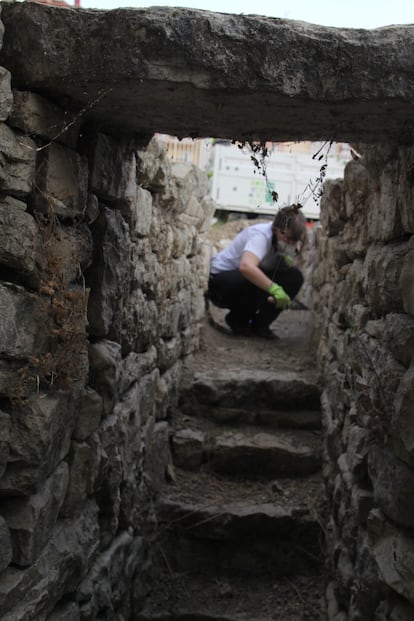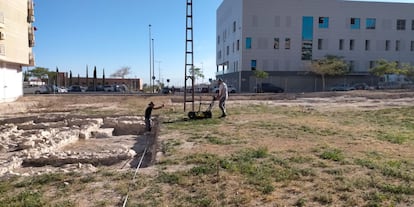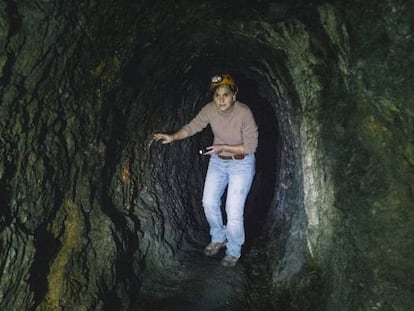Five thousand years of history buried in the undergrowth
The site of Marroquíes Bajos, one of the oldest inhabited settlements in Europe, languishes in the Spanish city of Jaén due to local government inertia and neglect

Weeds and undergrowth are so thick at the archaeological site of Marroquíes Bajos, they completely cover any trace of more than 5,000 years of Jaén’s history. The oldest settlement in the Spanish region of Andalusia, along with Los Millares, in Almeria, and one of the longest inhabited settlements in Europe, has been abandoned and all projects, whether museum or tourist related, ditched due to the inertia of the local authorities.
“Marroquíes Bajos is an archaeological zone of exceptional value,” says the archaeologist and professor of prehistory Arturo Ruiz referring to the 75-hectare site, where remains from the Chalcolithic to the Iberian, Roman, Visigoth and Islamic periods have surfaced. The perimeter fence of what became the Archaeological Park of Marroquíes, in plot C of the necropolis, was the last municipal intervention, undertaken by the previous socialist government and finished by the current administration, a coalition of the conservative Popular Party and a local collective, Jaén Merece Más (Jaén Deserves More).
“More than two meters of grass has grown over the various excavation sites, particularly affecting the Roman cistern and well, the area where both the first Iberian burial and one of the Chalcolithic rings were found,” says José Manuel Higueras, former counselor of Culture of Jaén. “The abandonment is clear to see.”
During Higueras’ time in the municipal government, guided tours, educational activities and even an archaeological volunteer camp were organized. The current City Council stresses that this year a meeting was called in July, but there was little public interest. The Council tends to forego mentioning the neglect suffered by the site.

The last works in plot C took place in the spring of last year, involving prospecting with georadar, a non-invasive archaeological technique for the detection of buried structures at different depths. This allowed a precise radiography of what is in the subsoil of what was sold as the future archaeological park of Marroquíes Bajos more than 20 years ago.
The exploration yielded interesting preliminary results, such as the presence of structural elements from different periods: dwellings, wells and part of a prehistoric Chalcolithic moat, whose existence had already been suggested by some previous surveys.
“Archaeological remains of various depths are detected, which is evidence of the great overlapping of different remnants, accumulated over the 5,000 years of history of this archaeological area that had a large central structure,” says Jesús García Sánchez, from Merida’s Institute of Archaeology (IAM), a leading center in this field. “This method is based on a radar sensor that emits a pulse to interact with the different materials it finds in its path and allow us to know the characteristics and geometry of the elements that are buried and also to understand the sites in a three-dimensional way,” adds García, who is also a researcher at the Spain’s national research center CSIC.

In three years of excavation in an area of barely 8,000 square meters, hundreds of findings have come to light that have allowed the most important chronological stages to be established, showing that, from the Chalcolithic to the Iberian, Roman, Visigoth and Islamic periods, there has been the presence of settlers in what is now the outlying areas of the city of Jaén. Some of the remains have thrown up the first examples of Iberian burials known in the city, and also the discovery of a Roman well from the 1st century.
The geophysical survey in the epicenter of Marroquíes Bajos was carried out by the company Construcciones Calderón, which has a significant reputation in the preservation and recovery of historical heritage, an area in which it has developed interventions in emblematic monuments such as the Alhambra, the Abadía del Sacromonte and the Cathedral of Granada besides the restoration of the walls of Jaén located on the Santa Catalina mountain.
Three years earlier, the Roman villa of Los Robles was discovered along with several sculptures “that provided valuable information about a fundamental period in Western culture, such as the establishment of Christianity and the end of pagan rites,” according to archaeologist Marcelo Castro. The pieces that were recovered and saved from the risk of plundering were a life-size head of a woman, as well as Venus, Priapus and Diana in a smaller format, and others in limestone, along with coins, glass and ceramics. The municipality of Jaen wants to install an olive oil tourism center next to the remains of this Roman villa.
Meanwhile, the Andalusian regional government has been planning for some years to build the City of Justice on the plot which marks the epicenter of Marroquíes Bajos. It is a site where an excavation carried out in 2010 located a pair of 4,500-years-old anthropomorphic idols, made of bone and reaching a height of 11 cm and 12 cm, which “come to signify the social change in power structures that takes place in the middle of the third millennium before our present era,” according to the director of the excavation, Vicente Barba. The project is dogged delays, and still lacks concrete deadlines.
The importance of this site was also flagged up in the documentary Atlantis Rising, produced by filmmaker James Cameron. The film put Marroquíes Bajos on the map by painting it as the epicenter of the myth of Atlantis. “We are convinced that Marroquíes Bajos is the remains of a city that is related to the legend and tradition of Atlantis. It is not a coincidence that these people built this city thinking in a concentric circular design,” says Georgeos Díaz-Montexano, expert in historical-scientific atlantology, and advisor and co-scriptwriter of the documentary that is available in more than 170 countries around the world.
Sign up for our weekly newsletter to get more English-language news coverage from EL PAÍS USA Edition
Tu suscripción se está usando en otro dispositivo
¿Quieres añadir otro usuario a tu suscripción?
Si continúas leyendo en este dispositivo, no se podrá leer en el otro.
FlechaTu suscripción se está usando en otro dispositivo y solo puedes acceder a EL PAÍS desde un dispositivo a la vez.
Si quieres compartir tu cuenta, cambia tu suscripción a la modalidad Premium, así podrás añadir otro usuario. Cada uno accederá con su propia cuenta de email, lo que os permitirá personalizar vuestra experiencia en EL PAÍS.
¿Tienes una suscripción de empresa? Accede aquí para contratar más cuentas.
En el caso de no saber quién está usando tu cuenta, te recomendamos cambiar tu contraseña aquí.
Si decides continuar compartiendo tu cuenta, este mensaje se mostrará en tu dispositivo y en el de la otra persona que está usando tu cuenta de forma indefinida, afectando a tu experiencia de lectura. Puedes consultar aquí los términos y condiciones de la suscripción digital.
More information
Archived In
Últimas noticias
There is as much life left to discover on planet Earth as that which is already known
Dozens presumed dead, around 100 injured in fire at Swiss Alps bar during New Year’s celebration
Is porn for women different from conventional porn? We spoke to those who make it
Cartagena de Indias is sinking: What can the city do to mitigate it?
Most viewed
- Sinaloa Cartel war is taking its toll on Los Chapitos
- Reinhard Genzel, Nobel laureate in physics: ‘One-minute videos will never give you the truth’
- Oona Chaplin: ‘I told James Cameron that I was living in a treehouse and starting a permaculture project with a friend’
- David King, chemist: ‘There are scientists studying how to cool the planet; nobody should stop these experiments from happening’
- Why the price of coffee has skyrocketed: from Brazilian plantations to specialty coffee houses











































